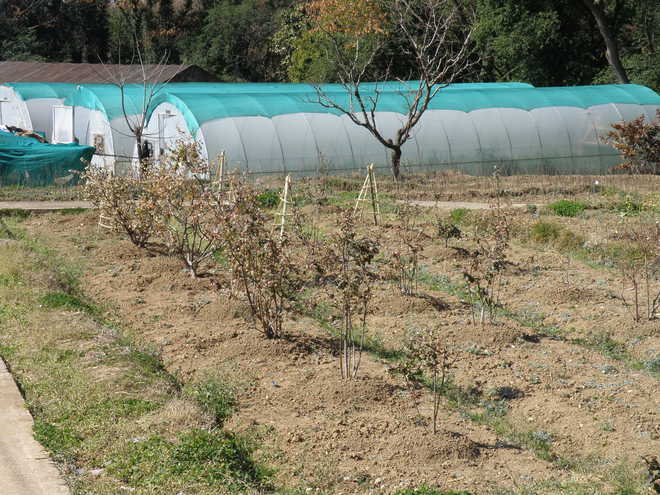Blueberry shows promise in Himachal
Dr Chiranjit Parmar
Though blueberry is as old as vegetation on earth, yet it has shot into prominence only during the 20th century. Till 50 years ago, it was only a wild growing fruit of the temperate regions in North Europe and North America.
People used to gather these fruits from forests during the season and store these for use later. One of the popular uses of blueberry for them was to use it as a filling in cakes etc. Then in ’90s, this fruit was discovered to be a very rich source of antioxidants and therefore entered into the category of category of ‘super fruits’. Health scientists are of the view that due to high content of antioxidants, this fruit is particularly useful for the elderly, as it retards the process of aging. This led to an increase in its demand. As it was not possible to meet this demand from wild growing plants, this fruit is now being brought under cultivation all over the world.
Till 10 years ago, this fruit was not known even in India. People started trying to grow it after it shot to fame. This started in Himachal Pradesh too. The first people to grow it were the fruit scientists at Agricultural University, Palampur. The Horticulture Department there established a small plantation of blueberry. Some progressive growers in Kullu area also tried to grow it. A private company near Kullu has also been able to cultivate it. Therefore, now enough evidence is there that blueberry can grow in Himachal Pradesh. Of course, more trials by researchers as well as growers are required to be carried out to standardise the cultivation practices for its farming under Himachal conditions.
Tips for cultivation
There are two important requirements for successful cultivation of blueberries. First is the choice of right variety. As blueberry bushes need winter chilling, which varies from 400 to 1,100 hours from variety to variety, so selection of right variety is the first prerequisite for success. No regular varietal trials have been conducted in Himachal so far. Therefore, no official recommendations about the suitability of varieties are there. Prospective growers will have to take a chance and start with as many varieties as possible. It will be safe to begin with the varieties of rabbit eye group, as these are reported to be more adaptive.
The second very important consideration is soil. Blueberry plants require acidic soils with a pH value of 4.2 to 5. It should not exceed 5.5 at all. Besides a desirable pH, soil should also have adequate moisture and should never become dry. In areas where soil pH is relatively higher, growers add small wood chips to the soil to bring the pH down to desired level.
New plants of blueberry can be raised from seed. But nurserymen prefer to propagate this fruit by using hardwood cuttings. Plants can also be successfully raised by tissue culture.
Harvesting and yield
Blueberry fruits are borne in clusters of 5 to 10. These take about six weeks from flowering to maturity. A fully grown plant of high bush type can produce 4 to 5 kg fruit. The blueberry bush has an orchard life of 20 years. Picking these fruits is of course a laborious process, which raises the cost of cultivation.
At present, fresh fruits of blueberries are available only at high-end stores of big cities. These sell at quite high price. A small plastic tray containing 100-gram fruit is sold between Rs 100 to Rs 150. Dried blueberries coming from abroad are also available at such stores. Blueberries are also sold online by various e-tailers such as Amazon and Flipkart.
(Writer is Mandi-based fruit scientist)
Many varieties
Blueberry is a plant of temperate region coming from the family Ericaceae, falling under the genus Vaccinium. There are many types of blueberries, but the following four types are most commonly cultivated. Fruits of all these types are nearly the same in taste and nutrient content.
- High bush blueberries (Vaccinium corymbosum): The plants of this type are usually 1.5 to 3-m high. These require an annual chilling from 800 to 1,100 hours and thus can only be grown in high hills.
- Low bush blueberries (Vaccinium angustifolium): These have low spreading plants.
- Rabbit eye (Vaccinium ashei): This type has a medium chilling requirement. This type is the most adaptable of all. It is being grown commercially in Argentina also. Rabbit eye blueberry should be more suitable for Himachal Pradesh. There are several varieties in this group too. As rabbit eye varieties are self-incompatible, so plants of more than one variety should be planted for ensuring cross pollination.
- Half high type: These have been developed by fruit breeders during recent decades by crossing high and low types.
Also sold online
At present, fresh fruits of blueberries are available only at high-end stores of big cities. These sell at quite high price. A small plastic tray containing 100-gram fruit is sold between Rs 100 to Rs 150. Dried blueberries coming from abroad are also available at such stores. Blueberries are also sold online by various e-tailers such as Amazon and Flipkart.









